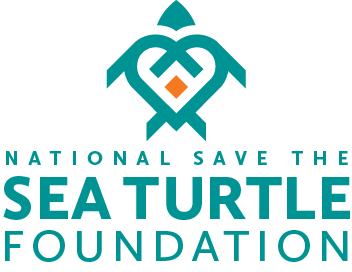2019 Sandy Point Leatherback
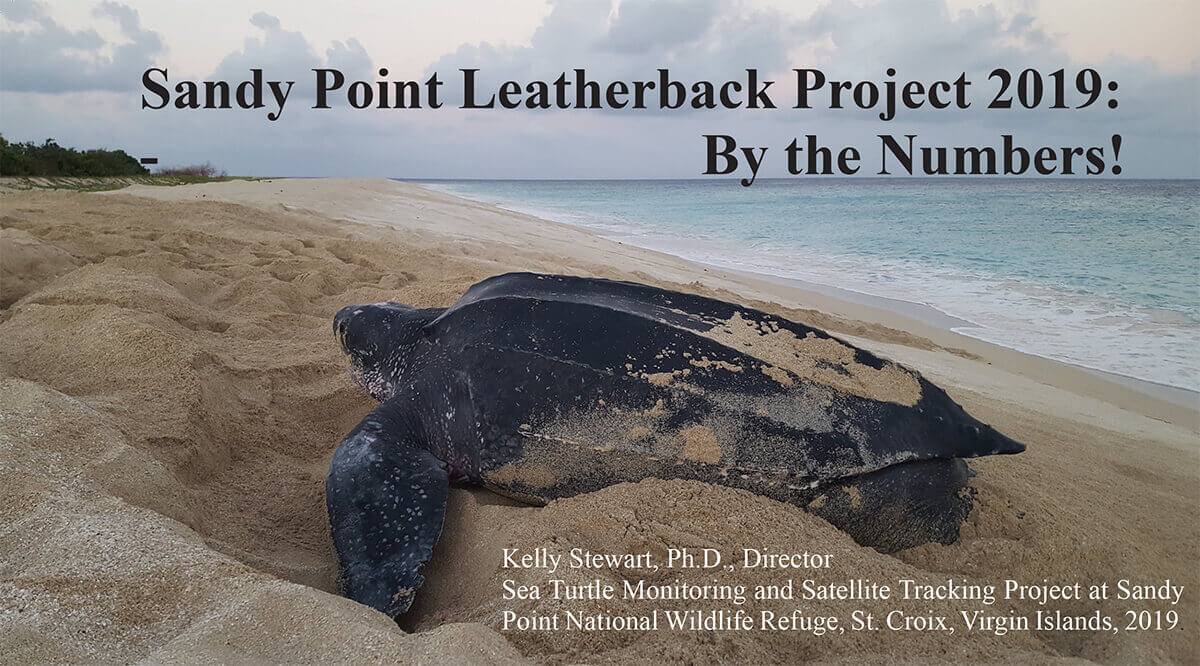
The Turtles!
55 leatherback turtle encounters
24 individual nesting females identified
2,100 leatherback hatchlings released
2 turtles found that have been nesting since 1988!
167.4 cm was the largest turtle
142.0 cm was the smallest turtle
6 was the record number of nests by one individual
Since 1977, leatherback turtles have been studied and protected at Sandy Point National Wildlife Refuge. Sandy Point lies at the southwestern tip of St. Croix (US Virgin Islands), jutting out into the Caribbean Sea. It has quick access to very deep water and dynamic nearshore currents that redistribute sand around the point seasonally. It is ideal nesting habitat for leatherbacks, although green and hawksbill turtles also use it. This refuge was officially created for the protection of leatherback nesting in 1984 and has supported the densest nesting of leatherbacks under US jurisdiction since that time. The refuge is closed to the public seasonally from April through August specifically for turtle nesting. Results of the intensive work here have resulted in a wealth of knowledge about leatherbacks, their nesting habits, site fidelity, nest environment and results of conservation practices
In order to complete the monitoring work, our team of students and volunteers patrol the 3.2-km nesting beach by foot every 45 minutes between 7:30 pm and 5:00 am to encounter each nesting leatherback. Incredibly, some females have been nesting at the refuge for over 30 years; they are identified by flipper and PIT tags. Each turtle is measured, tagged, sampled for genetics and the location of her nest is recorded by triangulation. If the nest is laid in a known erosion zone, the eggs are relocated to an area of the beach not prone to washout.
This has been a major management goal of the refuge for some time. Over 1,000 female leatherbacks have been identified since the project began. Nesting usually begins in March and continues through July. Another major component of the monitoring program involves protection of emerging nests from May through August. Leatherback hatchlings begin emerging in the early evening before dark and we have a team in place checking on nests that are due to emerge.
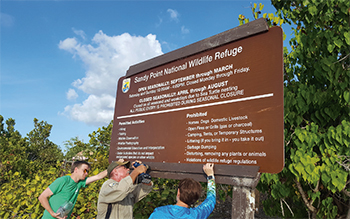
Volunteers help Refuge Manager Mike Evans fix the Sandy Point sign.
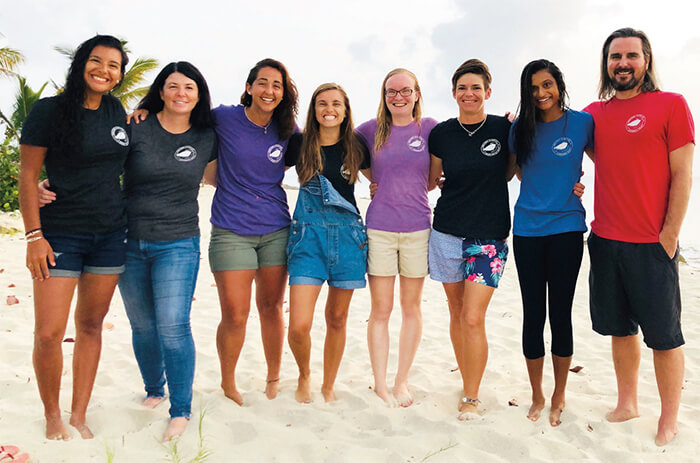
Some team members during late June: Dana, Kelly, Claire, Nina, Emma, Angie, Shreya, and Jeremy.
Hatchlings are protected from predators (mainly birds) as they make their way up to the surface and down the beach to the water. We conduct a genetics research project with the hatchlings to determine paternity and identify male breeding turtles in the population. The Fish and Wildlife Service supports a community program called Turtle Watch that guides visitors through either a nesting event with a female leatherback (April through mid-June) or a hatching event (mid-June through July). This program allows local residents to realize the importance and wonder of leatherback nesting in St. Croix. Each year, over 1,000 people participate in this outreach effort.
In 2017, the refuge was severely affected by Hurricane Maria and we are still evaluating the effects of the storm on nest distribution and success as well as habitat quality. The storm changed the nearshore environment by moving tremendous amounts of sand around and affecting the vegetation in a serious way. Most tall trees were knocked over, leaving gaps in the vegetation along the beach that usually block the light coming to the refuge beaches from nearby towns. Assessing the impacts of Maria will continue to be a major focus for our team this season, in addition to working with the turtles.
Last season, the team did evaluations of nest distribution, and compared pre-hurricane and post- hurricane nest success. All of these studies will be presented at the International Sea Turtle Symposium!
As seasons go, this past year on the Leatherback Project at Sandy Point was a weird one. We expected to see many of the females that had nested between 2009 and 2015. We hoped this might be the year, as recently turtles have been taking longer and longer to come back to nest. Instead, we had the lowest number of individual nesting turtles since 1990. To answer the question of why the turtles are not returning, or to find out where they are going, we were planning to start a satellite tagging program, and while we got our equipment ready to go (with the help of National Save the Sea Turtle Foundation), we just didn’t have the right leatherback candidates to deploy our tags. We will be starting right away at the beginning of next season with this program.
The People!
88 all-night patrols for nesting turtles
80 evening hatchling patrols
3,520 miles walked
30 volunteers, students and interns
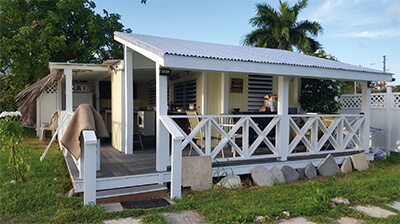
Turtle Camp for the Leatherback Project.
We did have two amazing turtle recaptures, however. Both Caroline (VI1231) and Max (VI1291) first nested in 1988, making it 31 years since they first nested. Both of them have been regular nesters over the years at Sandy Point. Between them, they have been seen over 100 times! They tie the record for maximum reproductive longevity (31 years) with AAG322, who was tagged in 1981 and last seen nesting in 2012. We think that these are possibly the longest records for a leatherback return anywhere in the world!
Despite wishing for more turtles, our volunteer research assistants still gained plenty of experience with turtle tagging, nest relocations (especially near the end of the season), and data entry, checking and analysis. We were able to take care of many of the important data entry jobs that we just don’t have time for during a regular season. This will be very helpful as a few of our research assistants will use portions of the data in their masters degrees and presentations at the next International Sea Turtle Symposium in Cartagena, Colombia.
We welcomed lots of visitors and short-term volunteers this season, including university students from Duke University, Winona State University and James Madison University. Dr. Larry Wood of The Florida Hawksbill Project joined us for a week along with yoga retreat participants from Breathe Salt & Yoga in Jupiter, FL. Our loyal St. Croix resident volunteers helped with night patrols, hatchling patrols and Turtle Watch. Thank you to everyone who helped this season!
Our project is updated regularly on our website at SeaTurtleCensus.com. We also have a Facebook page (@stxleatherbacks) that we regularly update. Our sincere thanks to The National Save The Sea Turtle Foundation for the support of our program again this year! The Sea Turtle Census Initiative is a project of The Ocean Foundation, a 501(c)(3) organization, working in cooperation with the US Fish and Wildlife Service and NOAA National Marine Fisheries Service Marine Turtle Genetics Program in La Jolla, California.
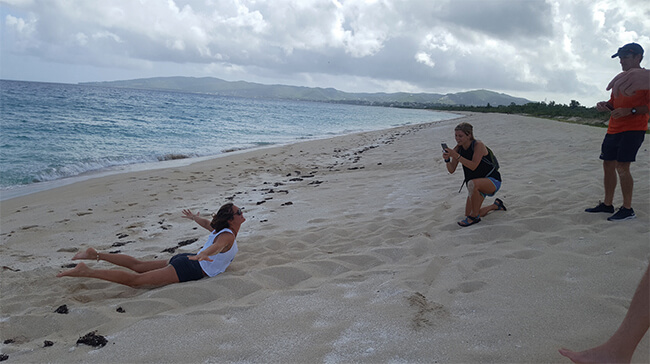
Breathe Salt & Yoga volunteers compare body size to a turtle track
Helping Sea Turtles Survive for 38 Years
A NON-PROFIT ORGANIZATION
State of Florida Registration Number CH-2841 | Internal Revenue Code 501 (c) (3)
Web Design & Development by Web Expressions, LLC
